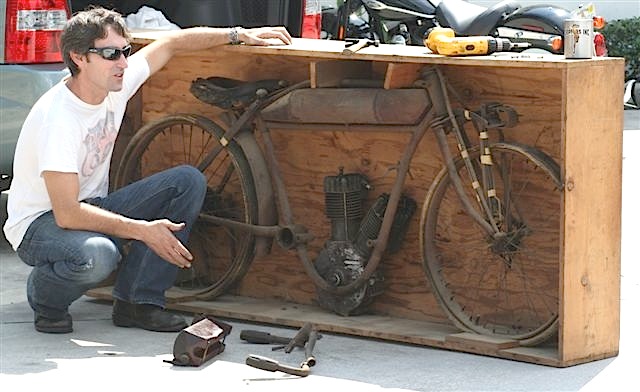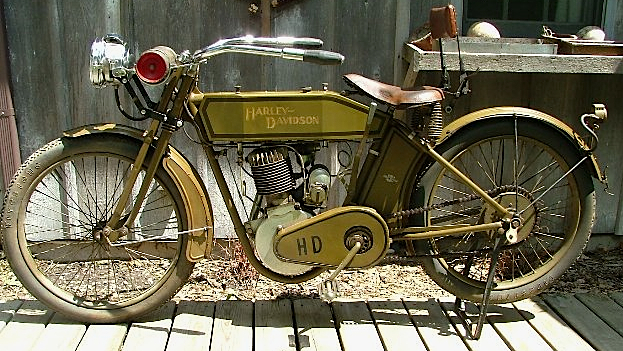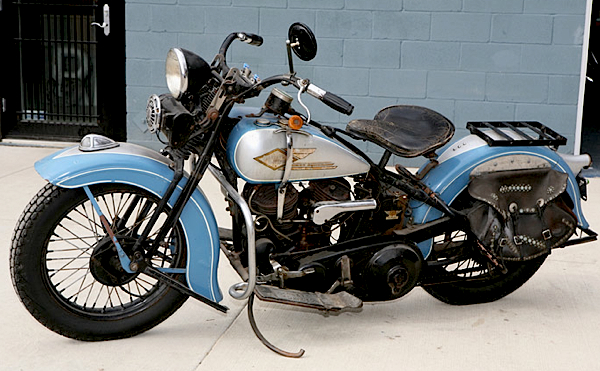The History Channel has done well for itself with several shows such as Pawn Stars and American Pickers. Some can argue seven ways til' Sunday about Mike and Frank scoring great deals and pulling the wool over some folks eyes about the values on the antiques, but an item is only as valuable as the person who pays for it.
We have seen many things bought for a low price then resold for a much higher value, namely quite a few toys we saved until a few years back when we put numerous Transformers, Star Wars and GI Joe action figures on ebay. Yep, you can guess it, we used the money to buy motorcycle parts and more specifically for our cafe racer that recently sold.
There is beauty in found treasure and in all actuality our favorite is the hunt for it. Whether it be scoring a deal on old parts, vintage tools or looking for great deals on a few items we need such as a Buell XB front end, rear caliper, sportster chain conversion kit and numerous others, all of these items keep us awake at night. Is it a sickness, is it a curse or could it just be our enthusiasm to continually build and discover? Well, we choose the latter as a life worth living is one worth scouring the earth in search of new adventure.
So why not dig into the mindset of Mike Wolfe from American Pickers and see what makes him tick...
Interview By Ben Marks
As co-host of History Channel’s “American Pickers” and the operator of Antique Archaeology, Mike Wolfe is known to millions of TV viewers as the guy who digs treasures out of barns, sheds, and basements. Although he began his pickin’ career buying, fixing-up, and selling vintage bicycles, he quickly graduated to machine-powered two-wheelers. In the second of several interviews (read our first one here), we spoke with Mike about his love of motorcycles, especially pre-World War II bikes.
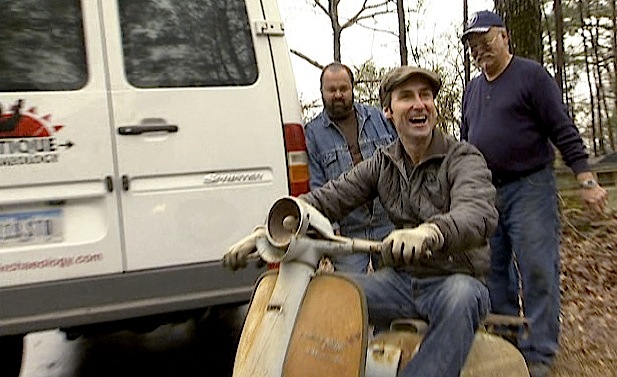 |
| Mike and co-host Frank Fritz (left) picked up a Lambretta frame during an episode in Alabama. They paid $40 for it at the beginning of the show, then sold it later for $250. |
I was 13 when I saw my first motorcycle. I was walking down the sidewalk when this guy who was like the high school champion stud—he was the team quarterback, got all the chicks, everything—did this incredible burnout on his Honda 900. I can remember the day so clearly, how warm it was, and him looking at me as I walked by. I thought, “Oh, man. That is the coolest thing in the world.” That’s what started me on my journey of wanting a motorcycle.
That year I got my first bike. It was a Kawasaki 100, a little Enduro. It was sitting in a friend’s garage, kind of beat-up and rundown. He had a couple older brothers who had moved on and left the bike. I traded him my stereo speakers for it. I never took it home, though, because my mother would have absolutely killed me if she knew I owned a motorcycle, so I kept it in different friends’ garages.
Motorcycles keep me on the road. All the other stuff is gravy.
Even though it was just a Kawasaki 100, I had no fear of riding it on the street. After a while I upgraded to a Honda Elsinore 250, which is also like an Enduro bike. Then I scraped together all my pennies and moved up to a Can-Am 250.
I was riding these bikes on the street with no license, no registration, no insurance, no nothing. I had a drawer full of tickets. The police got to the point where they would see me on the bike and then just wait at my house for me to come home. Yeah, I was one of those kids—by the time I was 14, I had 20 tickets. Because of all the problems I had on motorcycles when I was younger, I couldn’t get my driver’s license until I was 18.
Collectors Weekly: Were you also into bicycles during high school?
Wolfe: Yes, I had a Campy road bike, which took me everywhere. And I was repairing bicycles, too, but I could never get into the mechanics of a motorcycle. I wasn’t afraid to start wrenching on a motorcycle, but I never completed a project. It was mind-boggling to me.
Typically I would take an engine apart, mess around with it a bit, and get everything about halfway back together. Then I would put all the pieces in a bucket and go down to the local shade-tree mechanic and say, “Hey, here’s my motor.” I took a small-engines class in high school, but the way my mind worked and raced, I just didn’t have the patience for it.
Collectors Weekly: What are some of the most interesting motorcycles you’ve come across on a pick?
Wolfe: The rarest, earliest motorcycle I’ve ever found was a 1904 Imperial. It was basically just a frame, fork, front wheel, rear hub, and part of the fenders. I found it at an antique motorcycle meet, but the guy who owned the bike didn’t actually attend the meet. The whole time he just sat in his pickup truck in a parking lot across the street.
I noticed him all day long. I thought, “Well, that’s kind of odd,” so I rode by in my van and noticed the tip of a handlebar sticking out of the back of his pickup. I thought it was an early bicycle because of the curve of the handlebar and the age of the grip. So I pulled over.
Right away I knew it wasn’t a bicycle. There was no seat tube, and I could see that the rear hub was oversized and heavy duty. I had never seen a front suspension on a front fork like that before, and the frame had a head badge on that read “Imperial.”
Fortunately I was with a couple of guys who were into early motorcycles. They had never seen that fork before either, or that bike. I asked the guy, “Do you want to sell this bike?” and he said, “No. I just came here because I wanted people to tell me what they knew about it.” So I said to him, “Well, it’s an early motorcycle frame, it’s cool, and I’d like to have it.” Then I asked him to put a value on it. He told me, and I offered him three times what he estimated it was worth. So I was able to buy it. I wish I’d never let it go.
Collectors Weekly: What do early motorcycle collectors look for?
Wolfe: People who are into the early stuff are into the pre-1920, pre-1915 motorcycles. Pre-1910 American motorcycles are almost impossible to find, even though there were lots of manufacturers.
I’d take an engine apart and get it about halfway back together, then I’d put all the pieces in a bucket and bring them to a mechanic.
For example, that Imperial motorcycle I found was tagged under the name of American Motorcycle Manufacturing, which was owned by Pope. Pope also made bikes with the Monarch name on them; they had tons of different brands. Pope was the same gentleman, by the way, who made the Columbia high-wheeler bicycles.
These weren’t just safety bicycle frames jury-rigged with a motor. These were actual motorcycle frames, with a heavy-duty down tube that would be looped for the motor. If you look at some of the early Holley motorcycles, they actually manufactured a frame whose down tube was part of the casting of the motor.
The fork was different, too. It wasn’t a sloped crowned fork on the top. A lot of the early motorcycles had three-plate forks. The crown and the fork itself were also heavier.
Collectors Weekly: What drove the design of early motorcycles?
Wolfe: The wild thing about some of the early stuff, and the thing that’s always intrigued me, is that a lot of the manufacturers were also bicycle racers.
For example, Charles Metz, who made the Orient motorcycle, raced bicycles and made his own frames. Same with Oscar Hedstrom: Before he developed the Indian, he was building pace bikes for Orient. They got into it.
It was like there was this revolution in bicycles and motorcycles at the turn of the 20th century. Because I collect old stuff, a lot of people ask me what time period I would have liked to have lived in, and I always say, “the turn of the century” because everything was transportation-related back then.
I can imagine living in that time, and all of a sudden seeing some guy fly by at 14 miles an hour on a bicycle with a motor on it. It must have been like the feeling I had as a kid, standing on that corner and watching that guy fly by on his Honda 900. It must have been incredible.
My mother would have absolutely killed me if she knew I owned a motorcycle.
Think about all the thousands of patents for bicycles and motorcycles that were issued—from suspensions on the front forks and rear frame sections to the different kinds of seats we’re all riding on now. All that stuff was invented back then.
At the turn of the century, designers and engineers were just as interested in the diameter and butting of a tube as we are now. Toe clips were introduced for racers. Bicycles were so prevalent, you could buy a motor kit from E.R. Thomas of Buffalo, New York, to build your own Auto-Bi motorcycle. E.R. Thomas also made tricycles and fully assembled motorcycles. In my opinion, they don’t get enough respect. They made amazing bikes.
Collectors Weekly: Did Orient also make its own motors? You found a couple on a pick during Season One.
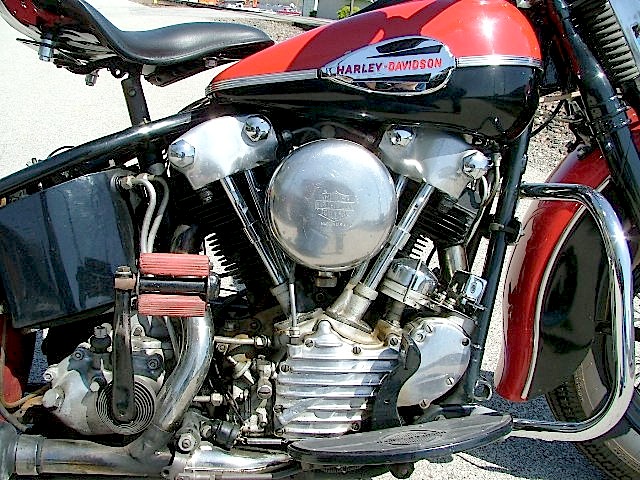 |
| The Harley Knucklehead, such as this 1941 from Mike's collection, gets its name from the shape of the tops of the cylinder heads. |
Wolfe: At first everything had a French DeDion Bouton motor on it. I don’t think Metz started manufacturing his own motors for the Orient until ’02. He changed the crankcase on them as far as how they opened up, as well as the cylinder heads.
I think the motor I found in that barn was for a car because the cylinder head is so tall, but that was really the only difference. It’s incredible to think that a lot of this stuff was made in bicycle factories.
It was really all just about transportation—it almost didn’t matter if a manufacturer was making a bicycle or a motorcycle or a car; they were all trying to make a go of it with this new technology.
Collectors Weekly: What about Indians? Do you have any of those?
Wolfe: I’ve got a 1948 Indian, as well as a 1913 that I found in a barn in Kansas in its original paint. The ’13 is a twin, with pedal cranks and a bicycle-esque look to it. That was the first year the Indian had a rear suspension.
I haven’t done anything to that bike. It sits in my office. It still has the hay and the dirt on it. I’ve wanted to keep it exactly like I found it. It’s just a really cool bike.
Collectors Weekly: What do you look for when you’re on a pick?
Wolfe: When you’re looking through a lot of stuff, it’s like you’re looking through this rusty spider web because so many things are layered on top of each other. You might see the rear dropout of a frame. You might see the pedal crank area where the eccentric went. You might see a head tube or a piece of a fork or handlebar. Any of that stuff is what you’re looking for in those big spider webs of junk.
And if I see an early motorcycle frame in a pile—I’m talking a huge pile of metal—I might spend days there if that’s what it takes to get to that frame. That’s how rare this stuff is.
Collectors Weekly: My sense is that you’re kind of a Harley-Davidson fan, yes?
Wolfe: Yes. Well, really, I’ve got a lot of Harleys, but the thing is for me, I like a lot of the smaller companies, too. For example, I had a couple Flying Merkels that I wish I’d never let go. These are things that keep me on the road—I dream about finding stuff like that. But, at the end of the day, it was stuff that I had to sell to make a living. I’ve been fortunate enough to keep eight bikes. I sold some of the best bikes I had.
But yes, I love Harley. The earliest Harley I have is a 1913 Harley Single. That came out of a barn in upstate New York. The guy’s father had restored the bike back in the late 1950s.
This is a cool story. Originally, the dad just had the frame and the wheels, no motor on it or anything. He used to pedal the thing around like it was a bicycle. When he got older, he decided to restore it because the paint on the thing was incredible.
His son was with him one day when they went into an old motorcycle shop. The father said, “Hey, do you have any early parts?” And the guy behind the counter says, “I have these.” He had the tanks and fenders, still wrapped in their original paper, sitting on a shelf. So now he had the tanks and the fenders in the original paint, and he restored the bike around those elements. Today that bike sits in my dining room. I love that bike. I was fortunate enough to keep that one.
Collectors Weekly: Do you ride any of your bikes?
Wolfe: Yes. The bike I ride the most is a 1934 Harley-Davidson VL. And then I’ve got a 1941 Knucklehead, as well as a 1937. The ’37 is the one we bought on the show. We’re working to make that bike correct now; we’re working on that one a lot.
Collectors Weekly: Do you ever come across British bikes, German bikes like BMWs, or Italian Ducatis?
Wolfe: I really haven’t found too many of those. The most common British bike you’re going to find is a Triumph. They had a huge dealer network and a lot of people rode them. Actually, just three days ago I bought a 1977 Triumph Bonneville 750 in Lynchburg, Tennessee. On a recent show we bought a ’67 Triumph Bonneville 650. It was in a barn in Rhode Island, and it had been restored in the ’90s. But I’m not really too familiar with a lot of early British stuff.
The wild thing about early motorcycles is that a lot of the manufacturers were also bicycle racers.
Everyone tells me, “Oh, if you could find James Dean’s Royal Enfield: That would be so badass.” I guess he rode a Royal Enfield from Indiana to Pennsylvania, or something like that, in the winter and the motor blew up on him. That’s supposed to be a rare bike, a J2 with a 500cc single cylinder. I’ve never found any Brough Superiors, but we recently bought a Vincent motor on the show. It was really nice. I sold that to the National Motorcycle Museum in Anamosa, Iowa.
Collectors Weekly: What’s hot right now for motorcycle collectors?
Wolfe: Anything that’s airflow and Art Deco, like the Harley Knuckleheads. They’re incredibly expensive, but really anything pre-1940 is where the money is. Indians from ’37 or ’38, the early Chiefs, are bringing crazy money now. Before, everybody wanted something skirted. Now they’re more interested in the Art Deco and airflow designs.
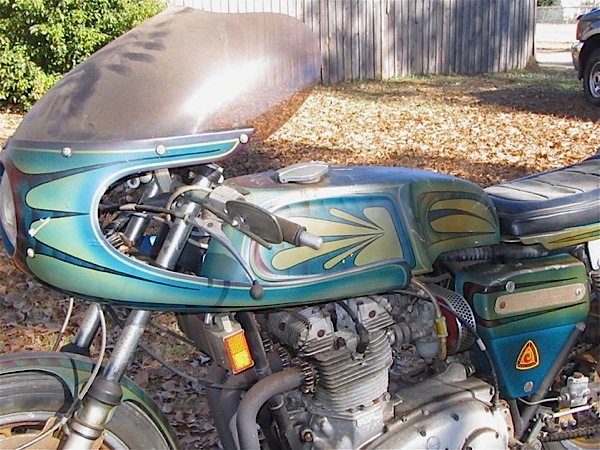 |
| This 1971 BSA triple, dubbed Mad Max, is Mike's latest restoration project, although he has no plans to touch the paint. |
On the other hand, everything has gone up. I’m not a huge fan of the AMF-era Harleys, the Shovelheads, but if I found one, I’d buy it. What’s happening is these younger guys want to get into collecting bikes, but you can’t do it anymore. It’s just too freaking crazy. The money is insane. So they start out by building out that Shovelhead. They’ll make it look like a Panhead. They’ll start with a bagger and strip it down, maybe make a bobber out of it. You can still buy a bike like that for less than 10 grand, or right around 10 grand, a nice running bike.
My buddies were at the 2010 Las Vegas motorcycle auction last January. At the time, the British stuff was attracting the big money. Not a lot of people can afford $50,000, $60,000, $75,000, or $150,000 for a motorcycle. Imagine trying to get into collecting something, and you got to start out at 100k. What’s the percentage of the population that can write that check?
Now people are building bikes around motors, which is great. You used to have to find a frame, the fork, all that stuff. Well, today you can buy a 1912 Harley chassis for 20 grand, brand new, paint-ready. It used to be that if you went to a meet and found a cool motor, you’d put it on a shelf. It wasn’t really worth anything because you were never going to find that chassis. Of course, now that the chassis are available, the motor prices shot have through the roof.
But here’s the deal: What keeps me on the road is anything early-motorcycle. That’s the stuff I dream about. All the other stuff I find, that’s the gravy on the potatoes, that’s what keeps me in business. I’ve had to learn how to buy all that other stuff because of my passion for these early motorcycles and early bicycles. Do I love turn-of-the-century cuckoo clocks? No. But I’m going to buy them because they keep me on the road buying the stuff that I love.
Collectors Weekly: Where are you headed next?
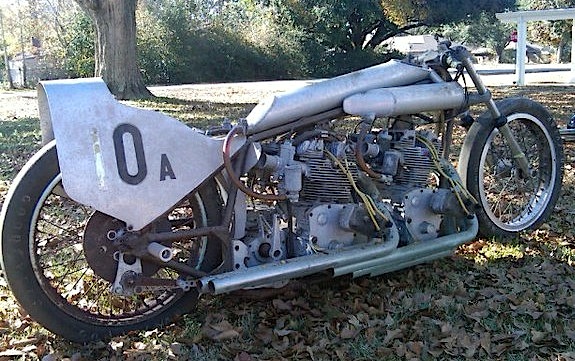 |
| A recent addition to Wolfe's motorcycle collection is a BSA racer from the 1970s, built to set land-speed records on the Bonneville Salt Flats |
Wolfe: Actually, today I’m driving about seven hours south of here to pick up some BSAs in Alabama. The seller was a factory racer for BSA; he set some records on the Bonneville Salt Flats. One of the bikes that he raced on the Salt Flats actually has two three-cylinder triple motors on it, one in front of the other. It looks like a freaking land rocket. I’m going to try to buy that.
He’s got another BSA that I’m really interested in. I think it’s a 1971. It’s a three-cylinder, and it’s got an incredible, ’70s-funkadelic paint job on it. Hopefully that’s what I’ll be riding this summer. I’m in Tennessee. We got the Natchez Trace down here. You can ride all the way to the Blue Ridge Parkway, and there are no straight roads in this state.

